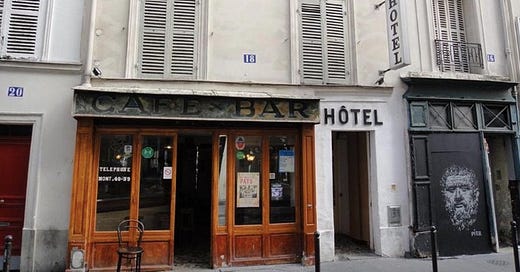Legend has it that parts of Paris are inundated with tourists this time of year: you can trip over one on Rue des Abbesses and fall into the arms of another, regain your balance, take two steps and run right into a tour group led by a portly guy waving a flag and broadcasting in English over a microphone, someone you swear you’ve seen playing piano somewhere before, pass through like a saumon leaping upriver before falling down the stairs to the métro like a weary rat returning to the den, only to hang there on weary, stepped-on feet while newcomers puzzle out the ticket buying machine which offers its services in five languages.
So it goes. But if you reach the boiling point, as I sometimes do, and head down the hill on a side street, say Aristide Bruant, named for a chansonnier during the Belle Epoque, pass the always interesting Gallery Hus and turn the first corner onto rue Veron…you’re in another world of long-slow quiet afternoons, tourists safely tucked away in the popular Thai resto close to the main drag.
I owe my discovery of Chez Amaad to my first native girlfriend who was enjoying the privileges of a sister’s apartment on rue Lepic. Amaad’s place became a regular haunt, too full of memories and too far away now for me to visit regularly when thirst strikes. What it and a few other spots on the hill taught me was that the Abos, the aborigines, the old Gauls, the Communards, don’t cede territory so easily. The Romans of Julius Caesar’s time are said to have scared them off, and when that didn’t work, his successors crucified them further up Montmartre. Against the odds they hang on and let the tourists hurry off to their inevitable Next Destination. They’re practically invisible but they’re there.



